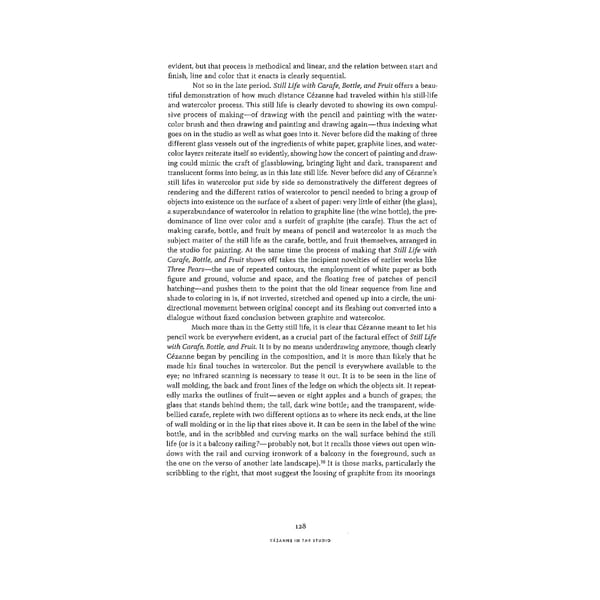evident, but that process is methodical and linear, and the relation between start and finish, line and color that it enacts is clearly sequential. Not so in the late period. Still Life with Carafe, Bottle, and Fruit offers a beau- tiful demonstration of how much distance Cezanne had traveled within his still-life and watercolor process. This still life is clearly devoted to showing its own compul- sive process of making—of drawing with the pencil and painting with the water- color brush and then drawing and painting and drawing again—thus indexing what goes on in the studio as well as what goes into it. Never before did the making of three different glass vessels out of the ingredients of white paper, graphite lines, and water- color layers reiterate itself so evidently, showing how the concert of painting and draw- ing could mimic the craft of glassblowing, bringing light and dark, transparent and translucent forms into being, as in this late still life. Never before did any of Cezanne's still lifes in watercolor put side by side so demonstratively the different degrees of rendering and the different ratios of watercolor to pencil needed to bring a group of objects into existence on the surface of a sheet of paper: very little of either (the glass), a superabundance of watercolor in relation to graphite line (the wine bottle), the pre- dominance of line over color and a surfeit of graphite (the carafe). Thus the act of making carafe, bottle, and fruit by means of pencil and watercolor is as much the subject matter of the still life as the carafe, bottle, and fruit themselves, arranged in the studio for painting. At the same time the process of making that Still Life with Carafe, Bottle, and Fruit shows off takes the incipient novelties of earlier works like Three Pears—the use of repeated contours, the employment of white paper as both figure and ground, volume and space, and the floating free of patches of pencil hatching—and pushes them to the point that the old linear sequence from line and shade to coloring in is, if not inverted, stretched and opened up into a circle, the uni- directional movement between original concept and its fleshing out converted into a dialogue without fixed conclusion between graphite and watercolor. Much more than in the Getty still life, it is clear that Cezanne meant to let his pencil work be everywhere evident, as a crucial part of the factural effect of Still Life with Carafe, Bottle, and Fruit. It is by no means underdrawing anymore, though clearly Cezanne began by penciling in the composition, and it is more than likely that he made his final touches in watercolor. But the pencil is everywhere available to the eye; no infrared scanning is necessary to tease it out. It is to be seen in the line of wall molding, the back and front lines of the ledge on which the objects sit. It repeat- edly marks the outlines of fruit—seven or eight apples and a bunch of grapes; the glass that stands behind them; the tall, dark wine bottle; and the transparent, wide- bellied carafe, replete with two different options as to where its neck ends, at the line of wall molding or in the lip that rises above it. It can be seen in the label of the wine bottle, and in the scribbled and curving marks on the wall surface behind the still life (or is it a balcony railing?—probably not, but it recalls those views out open win- dows with the rail and curving ironwork of a balcony in the foreground, such as 10 the one on the verso of another late landscape). It is those marks, particularly the scribbling to the right, that most suggest the loosing of graphite from its moorings 128 CEZANNE IN THE STUDIO
 Cézanne in the Studio: Still Life in Watercolors Page 142 Page 144
Cézanne in the Studio: Still Life in Watercolors Page 142 Page 144